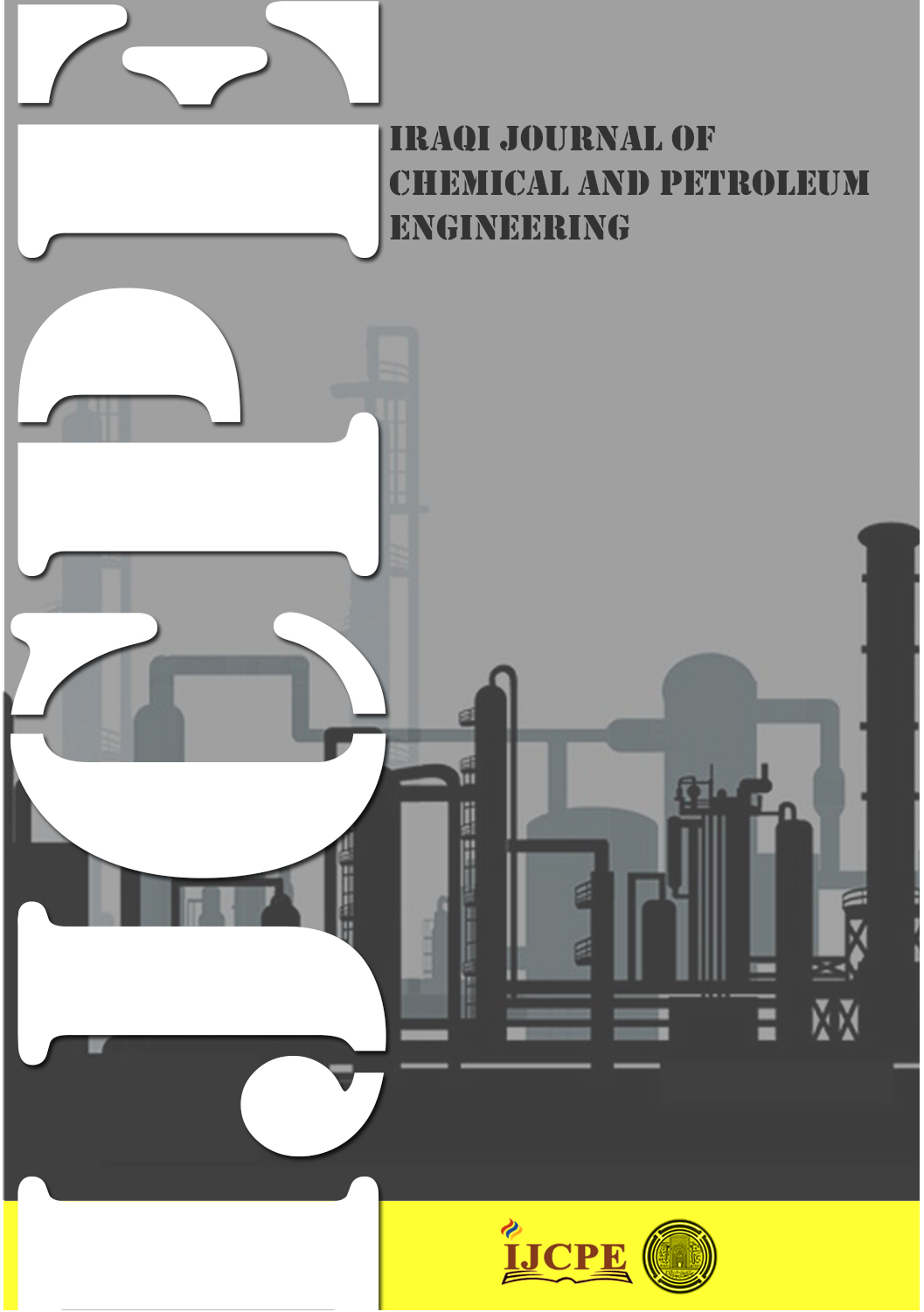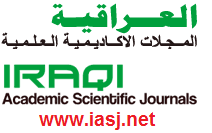Determination of controlling fouling mechanism using the Hermia models and estimation of the manufacturing costs of the modified polyvinylidene fluoride-based ultrafiltration membranes
DOI:
https://doi.org/10.31699/IJCPE.2025.1.7Keywords:
PVDF membrane; PEG, Tin oxide (SnO2); Fouling mechanisms; Hermia models; Economic estimationAbstract
Membrane fouling is the main problem that limits the use of membrane technology. This work focuses on using the Hermia models to determine the controlling fouling mechanisms, including intermediate pore blocking, complete pore blocking, standard pore blocking, and cake formation. Also, it investigates the estimation of the manufacturing costs, which included the costs of preparation materials and energy consumed during the preparation and casting processes of the polyvinylidene fluoride/polyethylene glycol (PVDF/PEG) and PVDF/PEG-tin oxide nanoparticles (PVDF/PEG-SnO2 NPs) membranes. The results of Hermia’s models were applied on the first, third, and fifth cycles of the rhodamine B dye solution filtration processes. Depending on linear fitting parameters, the membrane fouling occurred in all fouling mechanism types simultaneously. However, the predominating fouling mechanism was cake formation followed by intermediate pore blocking. Analysis of the parameters of the fouling models validated that the irreversible fouling exceeded the reversible fouling when the correlation factor (R2) value was higher than 0.95, which explains the continuous reduction of the permeate flux for both studied membranes. The estimated cost of the locally manufactured PVDF-based membranes did not surpass 80 $/m2 of the membrane. Also, the locally fabricated flat sheet ultrafiltration membranes are cheaper than other pristine PVDF membranes manufactured by Guochukeji Technology (Xiamen) Company.
Received on 06/01/2025
Received in Revised Form on 22/02/2025
Accepted on 22/02/2025
Published on 30/03/2025
References
[1] A. S. Adday and S. M. Al-Jubouri, “Photocatalytic oxidative removal of the organic pollutant from wastewater using recyclable Ag2O@CRA heterojunction photocatalyst,” Case Studies in Chemical and Environmental Engineering, vol. 10, Dec. 2024, https://doi.org/10.1016/j.cscee.2024.100852
[2] A. G. Saleem and S. M. Al-Jubouri, “Separation performance of cationic and anionic dyes from water using polyvinylidene fluoride-based ultrafiltration membrane incorporating polyethylene glycol,” Desalination and Water Treatment, vol. 319, Jul. 2024, https://doi.org/10.1016/j.dwt.2024.100546
[3] S. Yadav, K. S. Tiwari, C. Gupta, M. K. Tiwari, A. Khan, and S. P. Sonkar, “A brief review on natural dyes, pigments: Recent advances and future perspectives,” Results in Chemistry, Jan. 01, 2023, Elsevier B.V. https://doi.org/10.1016/j.rechem.2022.100733
[4] Nachiyar V. C., A. D. Rakshi, S. Sandhya, N. Britlin Deva Jebasta, and J. Nellore, “Developments in treatment technologies of dye-containing effluent: A review,” Case Studies in Chemical and Environmental Engineering, vol. 7, Jun. 2023, https://doi.org/10.1016/j.cscee.2023.100339
[5] A. E. Abdelhamid, A. E. Elsayed, M. Naguib, and E. A. Ali, “Effective Dye Removal by Acrylic-Based Membrane Constructed from Textile Fibers Waste,” Fibers and Polymers, Jun. 2023, https://doi.org/10.1007/s12221-023-00247-z
[6] A. A. E. A. Elfiky, M. F. Mubarak, M. Keshawy, I. E. T. El Sayed, and T. A. Moghny, “Novel nanofiltration membrane modified by metal oxide nanocomposite for dyes removal from wastewater,” Environment, Development and Sustainability, 2024, https://doi.org/10.1007/s10668-023-03444-1
[7] H. M. Solayman, M. A. Hossen, A. A. Aziz, N. Y. Yahya, K. H. Leong, L. C. Sim, M. U. Monir , and K. D. Zoh, “Performance evaluation of dye wastewater treatment technologies: A review,” Journal of Environmental Chemical Engineering, Jun. 01, 2023, Elsevier Ltd. https://doi.org/10.1016/j.jece.2023.109610
[8] D. Liu, T. Wang, and C. He, “Antifouling polyethersulfone membrane blended with a dual-mode amphiphilic copolymer,” Journal of Materials Science, vol. 51, no. 16, pp. 7383–7394, Aug. 2016, https://doi.org/10.1007/s10853-016-9904-9
[9] B. Khorshidi, S. A. Hosseini, G. Ma, M. McGregor, and M. Sadrzadeh, “Novel nanocomposite polyethersulfone- antimony tin oxide membrane with enhanced thermal, electrical and antifouling properties,” Polymer, vol. 163, pp. 48–56, Feb. 2019, https://doi.org/10.1016/j.polymer.2018.12.058
[10] S. Al-Jubouri, “Oily Water Treatment Using Ceramic Membrane,” Journal of Engineering, vol. 17, no. 2, Apr. 2011, https://doi.org/10.31026/j.eng.2011.02.05
[11] H. R. Amedi and M. Aghajani, “Economic Estimation of Various Membranes and Distillation for Propylene and Propane Separation,” Industrial & Engineering Chemistry Research, vol. 57, no. 12, pp. 4366–4376, Mar. 2018, https://doi.org/10.1021/acs.iecr.7b04169
[12] M. S. Shalaby, H. Abdallah, R. Wilken, A. M. Shaban, W. Abbas, G. Sołowski, and I. Sotnyk, “Economic assessment for TFC-RO membranes production for water desalination,” Chemical Engineering Science, vol. 288, Apr. 2024, https://doi.org/10.1016/j.ces.2024.119805
[13] Y. Dong, H. Wu, F. Yang, and S. Gray, “Cost and efficiency perspectives of ceramic membranes for water treatment,” Water Research, vol. 220, Jul. 2022, https://doi.org/10.1016/j.watres.2022.118629
[14] T. Gao, K. Xiao, J. Zhang, X. Zhang, X. Wang, S. Liang, J. Sun, F. Meng, and X. Huang, “Cost-benefit analysis and technical efficiency evaluation of full-scale membrane bioreactors for wastewater treatment using economic approaches,” Journal of Cleaner Production, vol. 301, Jun. 2021, https://doi.org/10.1016/j.jclepro.2021.126984
[15] A. El-Gendi, H. Abdallah, and A. Amin, “Economic study for blend membrane production,” Bulletin of the National Research Centre, vol. 45, no. 1, Dec. 2021, https://doi.org/10.1186/s42269-021-00584-0
[16] P. Yadav, N. Ismail, M. Essalhi, M. Tysklind, D. Athanassiadis, and N. Tavajohi, “Assessment of the environmental impact of polymeric membrane production,” Journal of Membrane Science, vol. 622, Mar. 2021, https://doi.org/10.1016/j.memsci.2020.118987
[17] S. M. Al-Jubouri, S. Al-Batty, R. K. S. Al-Hamd, R. Sims, M. W. Hakami, and S. K. Manirul Haque, “Sustainable environment through using porous materials: A review on wastewater treatment,” Asia-Pacific Journal of Chemical Engineering, vol. 18, issue 4, Jun. 2023, https://doi.org/10.1002/apj.2941
[18] H. Xu, K. Xiao, J. Yu, B. Huang, X. Wang, S. Liang, C. Wei, X. Wen, and X. Huang, “A simple method to identify the dominant fouling mechanisms during membrane filtration based on piecewise multiple linear regression,” Membranes, vol. 10, no. 8, pp. 1–14, Aug. 2020, https://doi.org/10.3390/membranes10080171
[19] L. Hou, Z. Wang, and P. Song, “A precise combined complete blocking and cake filtration model for describing the flux variation in membrane filtration process with BSA solution,” Journal of Membrane Science, vol. 542, pp. 186–194, 2017, https://doi.org/10.1016/j.memsci.2017.08.013
[20] S. A. Sadek and S. M. Al-Jubouri, “Structure and performance of polyvinylchloride microfiltration membranes improved by green silicon oxide nanoparticles for oil-in-water emulsion separation,” Materials Today Sustainability, vol. 24, Dec. 2023, https://doi.org/10.1016/j.mtsust.2023.100600
[21] Z. Chen, G. Chen, H. Xie, Z. Xu, Y. Li, J. Wan, L. Liu, and H. Mao, “Photocatalytic antifouling properties of novel PVDF membranes improved by incorporation of SnO2-GO nanocomposite for water treatment,” Separation and Purification Technology, vol. 259, Mar. 2021, https://doi.org/10.1016/j.seppur.2020.118184
[22] L. Marbelia, M. R. Bilad, A. Piassecka, P. S. Jishna, P. V. Naik, and I. F. J. Vankelecom, “Study of PVDF asymmetric membranes in a high-throughput membrane bioreactor (HT-MBR): Influence of phase inversion parameters and filtration performance,” Separation and Purification Technology, vol. 162, pp. 6–13, Apr. 2016, https://doi.org/10.1016/j.seppur.2016.02.008
[23] E. O. Ezugbe and S. Rathilal, “Membrane technologies in wastewater treatment: A review,” Membranes, vol. 10, issue 5, Apr. 2020, https://doi.org/10.3390/membranes10050089
[24] S. M. Abbas and S. M. Al-Jubouri, “High performance and antifouling zeolite@polyethersulfone/cellulose acetate asymmetric membrane for efficient separation of oily wastewater,” Journal of Environmental Chemical Engineering, vol. 12, no. 3, Jun. 2024, https://doi.org/10.1016/j.jece.2024.112775
[25] H. Koonani and M. Amirinejad, “Combined three mechanisms models for membrane fouling during microfiltration,” Journal of Membrane Science and Research, vol. 5, no. 4, pp. 274–282, 2019, https://doi.org/10.22079/jmsr.2019.95781.1224
[26] A. Y. Kirschner, Y. H. Cheng, D. R. Paul, R. W. Field, and B. D. Freeman, “Fouling mechanisms in constant flux crossflow ultrafiltration,” Journal of Membrane Science, vol. 574, pp. 65–75, Mar. 2019, https://doi.org/10.1016/j.memsci.2018.12.001
[27] S. A. Sadek, S. M. Al-Jubouri, and S. Al-Batty, “Investigating the Fouling Models of the Microfiltration Mixed Matrix Membranes-Based Oxide Nanoparticles Applied for Oil-in-Water Emulsion Separation,” Iraqi Journal of Chemical and Petroleum Engineering, vol. 25, no. 2, pp. 1–16, Jun. 2024, https://doi.org/10.31699/ijcpe.2024.2.1
[28] A. G. Saleem and S. M. Al-Jubouri, “Efficient Separation of Organic Dyes using Polyvinylidene Fluoride Polyethylene Glycol-Tin Oxide (PVDFPEG-SnO2) Nanoparticles Ultrafiltration Membrane,” Applied Science and Engineering Progress, vol. 17, no. Special Issue, Aug. 2024, https://doi.org/10.14416/j.asep.2024.08.001
[29] M. C. Vincent Vela, S. Álvarez Blanco, J. Lora García, and E. Bergantiños Rodríguez, “Analysis of membrane pore blocking models adapted to crossflow ultrafiltration in the ultrafiltration of PEG,” Chemical Engineering Journal, vol. 149, no. 1–3, pp. 232–241, Jul. 2009, https://doi.org/10.1016/j.cej.2008.10.027
[30] P. Kim, K. Park, H. G. Kim, and J. Kim, “Comparative analysis of fouling mechanisms of ceramic and polymeric micro-filtration membrane for algae harvesting,” Desalination and Water Treatment, vol. 173, pp. 12–20, Jan. 2020, https://doi.org/10.5004/dwt.2020.24697
[31] S. Emani, R. Uppaluri, and M. K. Purkait, “Cross flow microfiltration of oil-water emulsions using kaolin based low cost ceramic membranes,” Desalination, vol. 341, no. 1, pp. 61–71, May 2014, https://doi.org/10.1016/j.desal.2014.02.030
Downloads
Published
Issue
Section
License
Copyright (c) 2025 The Author(s). Published by College of Engineering, University of Baghdad.

This work is licensed under a Creative Commons Attribution 4.0 International License.













